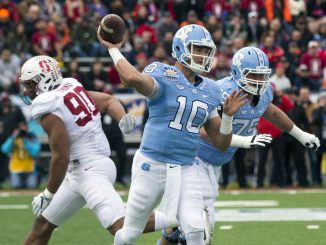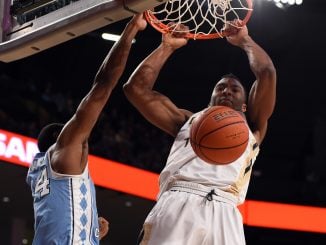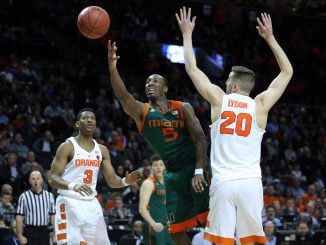
Cancer is something that will touch everyone’s life at some point. For those of us fortunate not to get a diagnosis or a scare, there are friends and relatives who won’t be so fortunate. Shawn Krest has been chosen by the American Cancer Society as one of the Real Men Wear Pink ambassadors for October, which is Breast Cancer Awareness Month. Each day of the month, he’ll be telling a story of how cancer has touched someone on one of the teams we root for. It could be a coach, a player, a retired legend or an arena worker. The disease doesn’t care how successful you are, how much money you have or, as we see in today’s post, whether you gave up risky behavior more than a decade earlier. To join in the fight against breast cancer, you can visit Shawn’s American Cancer Society page.
Lady Grooms was worried in practice, because she had to defend Edna Campbell.
Defending Campbell had always been a problem. As a freshman at Maryland, she hit a turnaround jumper in the final seconds to beat Duke in the 1987 ACC Tournament — a loss that Blue Devils coach Debbie Leonard described as, “Lousy. I can’t tell you how I really felt.”
Players struggled to defend her after she transferred to Texas and became a two-time all-conference player, when she made Team USA for the World Championships, and as an All-Star in the pros with five different teams over a 10-year career.
But Grooms wasn’t worried about defending Campbell because of how good she was at basketball. She had a different concern about going up against her Sacramento Monarchs teammate in practice.
“The only fear is when you hand-check on defense sometimes and hit her in the chest,” she told the Los Angeles Times at the time. I was concerned about that because she told me at one time she was still sore.”
Getting hit in the chest is what started everything for Edna Campbell.
Because of low salaries in the WNBA, Campbell, like many female players, spent her offseason playing overseas to help supplement her income. She’d played in Brazil, Hungary and Poland in previous years and spent her 2002 offseason in an Italian league.
During one game, she got elbowed hard in the chest, and the soreness didn’t go away. That, combined with flu-like symptoms she couldn’t shake, caused her to head back home to Pittsburgh to get checked out.
”When I left Italy to go home for the initial checkup,” Campbell told The New York Times, ”the officials for the team that I played for grumbled that I was just another American who was making excuses to bail out and go home. When I came back shortly after, I think they realized that that wasn’t the case.”
Doctors found a lump in her breast — one she hadn’t felt while inspecting what she thought was a bruise from the opponent’s elbow — and informed her it was cancerous.
With that, she made WNBA history in a way she never expected — as the first active player to battle breast cancer.
”OK,” she replied. ”What do I need to do?”
She had surgery to remove it, leaving Italy once again.
“’And then I worried,” she told the Times. ”Did they get it all? Had it spread? The fear of the unknown is the terrible thing.”
Campbell underwent chemotherapy, which required a two-hour drive from Sacramento — where she stayed on the bench for games, rooting on her teammates, recognizable to fans as the 5-foot-8 bald woman jumping around on the sideline — to Stanford every three weeks. One of the side effects of chemo was anemia, which often left her exhausted.
After that, she had radiation treatments.
“The hardest part was just watching the people that loved and cared about me dealing with it,” Campbell said at the time. “Sometimes I felt like I had to be strong for them.”
Chief among those people was her 18-year-old son, David.
“The initial shock threw him into a tailspin,” she said, “but he has been just as courageous as I’ve had to be.”
He found a classmate whose mother was going through the same thing, and the two friends were able to support each other.
“He was just terrified that his mother was dying,” Campbell said. “It was very hard for him,”
Eventually, she was ready to think about returning to the court. She worked with the strength coach first, who said he pushed her as hard as the male NBA players on the Kings. Then she hit the practice floor and let Grooms and her other teammates hit her.
“We put it to her,” Grooms told the L.A. paper. “We didn’t take it light on her, and she didn’t want that. If you tried to take it easy on her, she would get upset. She’s just a warrior.”
Six months after her diagnosis, Campbell returned to the court for the Monarchs’ final game of the regular season. She was still in treatment, and, in fact, had a radiation treatment that morning, before going to the arena for pregame shootaround.
She received an ovation before the game and another one when she came off the bench to enter the game for the first time.
She scored four points in 12 minutes.
It was later voted the most inspirational moment in WNBA history.
She went on to play three more seasons and scored 393 of her 1,143 career WNBA points after beating cancer.
“I had to dig deep to find a different Edna, a stronger Edna,” she told the L.A. Times. “But I want people to know that a tough time doesn’t mean the end of the world. At the end of that tough period, you’re gonna look in the mirror and see a different person. And chances are, that person is gonna be able to do a lot more than they were able to do before.”
Previous stories in the series include the Carolina Hurricanes’ Stelio Mattheos, Ron Rivera, Brian Piccolo, Brett Butler, Quincy Monk, Anthony Rizzo, Jon Lester, Carlos Carrasco, Daniel Norris, Trey Mancini, Jameson Taillon, Eric Davis and Chad Bettis. To donate to the American Cancer Society’s fight against cancer, visit the Real Men Wear Pink campaign page.



